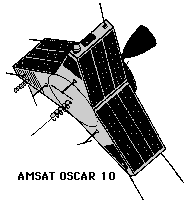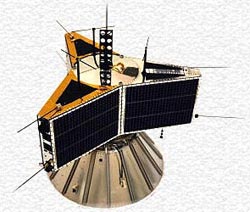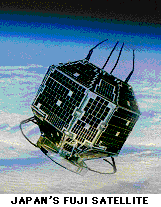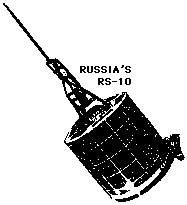|
The growth of interest among Amateur Radio operators around the world in building and sending hamsats to orbit exploded in the 1980s. In fact, the year 1981 was a record launch year. Eight hamsats were blasted to space that year -- a tie with 1990 for the most Amateur Radio satellites launched in one year. Here is a chronological summary of the seventeen Amateur Radio satellites and amateur-related satellites, launched in the 1980s:
1980: Phase-3A
At the end of the 1970s, as more and more Amateur Radio operators were sharing the fun of talking via satellite, AMSAT began work on a new generation of larger Phase-3 satellites.
The third-generation would be more complex spacecraft, using higher radio frequencies, and flying Molniya orbits. Phase-3 satellites would be over ground stations for hours at a time.
The first Phase-3 spacecraft, nine years in planning and four years in construction, was built, integrated, and tested at Goddard. Hams in Canada, Hungary, Japan, West Germany and the United States built parts for the spacecraft.
The satellite was to be launched on the second flight of Europe's new Ariane rocket from a site outside Kourou, French Guiana, on the northeast coast of South America. In a promising development, the first Ariane rocket made a successful flight from Kourou in December 1979.
Unfortunately, the second Ariane and Phase-3A were destroyed May 23, 1980, in a European Space Agency launch failure during liftoff from Kourou.
With the launch window open that day, breakdowns and rain in French Guiana forced three hours of holds. Finally, a go order was signaled and the Ariane fired. Three minutes into the flight, as the Ariane was lumbering upward from the South American coastline, the Ariane's first stage failed. The Phase-3A hamsat fell to the Atlantic Ocean and sank hundreds of feet to the bottom.
Within weeks, AMSAT began work on Phase-3B which would go to space in 1983.
-
AMSAT and Phase-3A — Recovering From Disaster
Most USSR Amateur Radio satellites were called Radiosputnik, but three had a different name, Iskra or "spark" in Russian. Students and radio amateurs at Moscow's Ordzhjonikidze Aviation Institute built the 62-lb. satellites, each powered by solar cells. Each had a transponder, telemetry beacon, ground-command radio, Codestore message bulletin board, and computer with memory.
The satellite transponders received at 21 MHz and transmitted at 28 MHz. Their telemetry beacons were near 29 MHz.
Controlled by ground stations at Moscow and Kaluga, Iskras were intended for communication among Eastern Bloc hams in Bulgaria, Cuba, Czechoslovakia, East Germany, Hungary, Laos, Mongolia, Poland, Romania, USSR and Vietnam.
Iskra-1 was launched July 10, 1981, on an A-1 rocket from the Northern Cosmodrome at Plesetsk to a 400-mi.-high polar orbit. After 13 weeks, it burned in the atmosphere October 7, 1981. Iskra 2 Iskra 3
-
Russian Sparks in Space
 1981: UoSAT-OSCAR 9
1981: UoSAT-OSCAR 9
Great Britain was an early leader in spaceflight and satellite technology, launching its Black Knight satellite from Australia in 1971. Students at the University of Surrey were eager to get hands on experience. Those who were radio amateurs designed and built a Phase-2 hamsat known as UoSAT, short for University of Surrey Satellite.
The 115-lb. science and education satellite was blasted to a 340-mi.-high polar orbit October 6, 1981, on a U.S. Delta rocket from Vandenberg Air Force Base, California.
In space, the hamsat was called UoSAT-OSCAR-9, or simply UO-9. Sometimes it was referred to as UoSAT-1.
UO-9 transmitted data and had a television camera which sent pictures to Earth with 2 km or 1.24 mi. resolution. The satellite had one of the earliest two-dimensional charge-coupled device (CCD) arrays forming the first low-cost CCD television camera in orbit. The resulting images transmitted from space were spectacular, considering the freshness of its technology. UO-9 was not a stabilized Earth-pointing satellite so the areas covered by its photos were random.
The hamsat had a magnetometer and detectors for radiation and particles. Two particle counters detected solar activity and auroras as they interfered with radio signals.
UO-9 also had a synthesized radio voice with 150-word vocabulary to read out spacecraft condition reports. Students around the world learned about space science by tuning receivers to OSCAR-9's so-called Digitalker.
The hamsat's radio beacons transmitted at 145 and 435 MHz. For propagation studies, there were additional beacons at shortwave frequencies near 7, 14, 21 and 28 MHz and microwave frequencies near 2 and 10 GHz.
UO-9 had Codestore for messages and a voice synthesizer for educational demonstrations. A control computer in the satellite could be reprogrammed from the ground. The satellite did not have a transponder for general chatting.
In 1982, a software error mistakenly turned on both the 145 and 435 MHz beacons at the same time, preventing the hamsat's receiver from hearing signals from controllers. Surrey hams called on radio amateurs at Stanford University, California, to override the jamming. Stanford hams used a 150-ft. dish antenna to transmit power equal to 15 million watts toward the satellite. It worked. After six months of running out of control in space, OSCAR-9 heard and understood what it was to do. Later, after eight years in orbit more than 300 miles above Earth, OSCAR-9 burned in the atmosphere October 13, 1989.
1981: Radiosputniks 3-8
As the 1980s dawned, the Amateur Radio club at the University of Moscow was busy building a covey of new Amateur Radio satellites.
Like RS-1 and RS-2, the six new Radiosputniks each weighed 88 lbs. and were cylinders 17 in. in diameter and 15 in. long.
The Soviet government launched the sextuplet December 17, 1981, on one C-1 rocket from the Northern Cosmodrome at Plesetsk to 1,000 miles altitude. At that time, it was the largest clutch of Amateur Radio satellites ever orbited at one time.
Designated Radiosputnik-3 (RS-3) through Radiosputnik-8 (RS-8), they were in orbits similar to those used by RS-1 and RS-2. They circled the globe every 119 minutes. The satellites sometimes also were referred to as Radio-3 through Radio-8.
The six satellites had transponders receiving at 145 MHz and transmitting at 29 MHz. They also had store-and-forward mailboxes, solar cells and a Morse Code temperature and voltage data beacon.
Some carried an "autotransponder" electronic robot operator. Hams on the ground could call a satellite and the robot would respond with a greeting and signal report.
The usefulness of each RS satellite ended as its battery failed. RS-5 and RS-7 were able to stay on the air until 1988. Today, all six are dead in orbit at altitudes around 1,000 miles.
1982: Iskra 2
The USSR's Salyut-7 space station was launched to Earth orbit April 19, 1982, with the second 62-lb. Iskra bundled up inside. Cosmonauts Anatoli Berezovoi and Valentin Lebedev blasted off from Baikonur Cosmodrome May 13 in a Soyuz transport. They docked at Salyut-7 two days later on May 15 and opened up the new station.
The cosmonauts unwrapped Iskra-2 and pushed it out an airlock on May 17 at an altitude of 210 miles. Moscow TV showed live coverage of that "hand launch" allowing the Ordzhjonikidze Aviation Institute students to see their satellite go into its own orbit. Iskra 1 Iskra 3
Iskra-2's telemetry was at 29 MHz. Since it started life in such a low orbit, the satellite was able to remain in space only about seven weeks before burning in the atmosphere July 9, 1982.
-
Russian Sparks in Space
On November 18, Berezovoi and Lebedev, hand launched Iskra-3 from an airlock at an altitude of 220 miles.
Even though Iskra-3 was much like Iskra-2, it suffered from internal overheating and didn't work as well. Iskra-3's telemetry beacon also was at 29 MHz. The third Iskra remained in space only four weeks before descending into the atmosphere and burning December 16, 1982. Iskra 1 Iskra 2
-
Russian Sparks in Space
 1983: AMSAT-OSCAR 10
1983: AMSAT-OSCAR 10
Shortly after its Phase-3A satellite sank in the Atlantic in 1980, AMSAT started work on Phase-3B. The 200-lb. clone was built mostly by German hams and launched on an Ariane June 16, 1983. It was named AMSAT-OSCAR-10.
Seconds after dropping off AO-10 in orbit, the Ariane bumped it, damaging an antenna on the hamsat and spinning the satellite wildly away. AMSAT had to wait for the satellite to stabilize in space before firing an internal thruster to change the orbit July 11.
The thruster didn't shut off as ordered and blasted 50 percent longer than planned. That threw the satellite into an exaggerated orbit taking it nearly twice as far away from Earth as planned.
Another kick-motor firing was attempted July 26, but helium had leaked from the satellite after the Ariane bump and fuel valves didn't operate. AO-10 ended in an uncontrollable orbit ranging from 2,390 miles to 22,126 miles.
 Paul Willmott drawing of AO-10 from the AMSAT-OSCAR 10 site of Stacey Mills, W4SM |
AO-10's transponders worked, but the broken antenna and low inclination made it less useful. Its signals were weak. Access time was limited. Even so, hundreds of radio amateurs used AO-10.
In 1986, intense subatomic particles trapped in Earth's magnetic field bombarded AO-10's computer memory chips, leaving false information behind. The memory began to turn up mysterious data bits and the satellite became harder to control.
AO-10's transponders switched off from time to time as voltage dropped when sunlight was low. The satellite required solar illumination 90 percent of the time, but sometimes received only 50. Then AO-10 would turn itself off and a command station would be required to transmit a reset order.
After the AO-10 launch, AMSAT started building a third Phase-3 satellite to be launched in 1988. AO-10 continues to transmit signals, but satellites launched later attracted most of its users.
-
AMSAT and AO-10 — Recovering From Disaster
The second science and education satellite built by students at England's University of Surrey was UoSAT-B, launched March 2, 1984, from California to a 430-mi.-high polar orbit. The 132-lb. hamsat was renamed UoSAT-OSCAR 11 (UO-11). It also has been called UoSAT-2.
UO-11's beacons transmit at 145, 435 and 2401 MHz. It handles messages while photographing aurora over the Poles with a sensitive camera which stores the images in memory.
Digital telemetry beacons relay news bulletins from AMSAT and UoSAT, which is headquartered at the Spacecraft Engineering Research Unit, Electrical Engineering, University of Surrey, Guildford, Surrey, GU2 5XH, England.
1985: NUsat
Northern Utah Satellite (NUsat) was not an amateur-radio satellite, but an amateur-built satellite used as a radar calibration target. It was an important step into space for a college which later became a university and built other satellites.
Students at a Center for AeroSpace Technology (CAST) at Weber State College, Ogden, Utah, designed NUsat. The 26-sided polyhedron satellite was built by Morton Thiokol, Inc., Brigham City, Utah, for WSC in coordination with the Federal Aviation Administration (FAA).
NUsat was ferried to an altitude of 219 miles in shuttle Challenger and dropped overboard April 29, 1985-the first payload ejected from a NASA GAScan to an orbit apart from a shuttle's orbit.
A GAScan is a Get Away Special Canister, a container for small payloads. With the 115-lb. NUsat in it, the GAScan weighed 433 lbs.
NUsat was used to calibrate air traffic control radar systems by measuring antenna patterns for ground-based radars operated in the United States and in member countries of the International Civil Aviation Organization. After 595 days in orbit, NUsat burned December 15, 1986. CAST later built another satellite, WO-18, for launch in 1990.
 1986: Fuji-OSCAR 12
1986: Fuji-OSCAR 12
Japanese radio amateurs built their first Japan Amateur Satellite (JAS-1a) and sent it to a 932-mi.-high orbit August 12, 1986, from Japan's Tanegashima Space Center. AMSAT labeled it OSCAR-12. Japanese hams called it Fuji, or wisteria. The Japanese name their satellites after flowers. It came to be known as Fuji-OSCAR-12.
FO-12 had a transponder which received at 145 and retransmitted at 435 MHz. Primarily a pacsat, Fuji's transponder could be used either as a message bulletin-board or as a voice repeater. Fuji's telemetry beacon sent data in 20-words-per minute Morse.
The mailbox in the sky received typewritten messages from individual ham stations and stored them in a 1.5 megabyte RAM memory. This electronic message center permitted amateurs on one side of the world to place messages on the satellite's bulletin board to be removed by others when the satellite was on the far side of the globe.
Users were disappointed when FO-12's solar generator was unable to produce sufficient electricity for Fuji's battery. Japanese controllers were forced to turn the satellite off November 5, 1989. FO-12 remains in orbit and a replacement hamsat, JAS-1b, was launched in 1990.
Radiosputnik-9
Soviet hams wanted to launch a new hamsat in the mid-1980s, but launch of Radiosputnik-9 was delayed repeatedly. Finally, the flight was canceled and the number RS-9 retired permanently.
 1987: Radiosputniks 10 and 11
1987: Radiosputniks 10 and 11
Soviet hams delighted the amateur satellite world June 23, 1987, with the launch of a combo package of hamsats, RS-10 and RS-11, aboard one large government spacecraft.
Radiosputnik-10 and Radiosputnik-11 went to a 621-mi.-high circular orbit as part of the Russian navigation satellite Cosmos 1861 which circles the globe every 105 minutes.
Part of a Russian system similar to the U.S. Navstar series of global positioning satellites (GPS), Cosmos 1861 helps Russian fishing fleets locate themselves on the world's oceans.
RS-10 and RS-11 were unique hamsats, at the time, in sharing space aboard the navsat. Hamsats usually get free piggy-back rides to space on government rockets, but in space they are separate payloads dropped off in at least slightly different orbits. By comparison, Cosmos 1861, RS-10 and RS-11 are just one big package with the ham-radio sections sharing electrical power generated by the Cosmos 1861 solar wings.
RS-10 and RS-11 telemetry beacons transmit near 29 and 145 MHz. The satellites have identical shortwave and vhf transponders, but frequencies are different. Hams on the ground send signals to RS-10 and RS-11 on frequencies near 21 and 145 MHz. Downlink signals from the satellites are at 29 and 145 MHz. Cosmos 1861 also has a transmitter, at a frequency near 150 MHz.
A robot radio operator, known as an autotransponder, is built into RS-10 and RS-11. To contact one of the robots, a ham on the ground transmits Morse code on 21 or 145 MHz. The satellite's computer returns a greeting, signal report and contact number on its telemetry beacon frequency, as if it were a human operator.
1988: AMSAT-OSCAR 13
With its second Phase-3 satellite safely in orbit in 1983, AMSAT started work on a third which was launched on an Ariane rocket June 15, 1988. Phase-3C was renamed AMSAT-OSCAR-13.
In its Molniya-style elliptical orbit, AO-13 swings from as close as 1,500 miles out to 22,000 miles from Earth.
AO-13 was the most complex amateur satellite to date. It offered four transponders for packet, facsimile (fax), slow-scan television (sstv), voice (ssb), radioteletype (rtty) and Morse code (cw).
Transponders receive at 435 and 1269 MHz and retransmit at 145, 435 and 2400 MHz. The satellite's computer follows a calendar in switching among transponders modes. Telemetry beacons transmit data via packet, cw and rtty.
AO-13 provides near-hemispheric coverage linking continents for up to eight hours at a time. During weekly on-the-air meetings, commentators talk about satellite topics via AO-13.
The hamsat delivered essential communications in 1992 after Hurricane Iniki leveled parts of Hawaii. After normal public circuits broke down, AO-13 and other hamsats moved health and welfare messages from devastated areas to anxious relatives and friends.
Solar power makes sunlight important. Even a partial eclipse of the Sun by the Moon can affect a satellite. During a 1992 eclipse, sunlight reaching AO-13 was cut 40 percent. Twilight was reported in the satellite's housekeeping telemetry as a drop in solar panel temperature. The low illumination necessitated turning off a transponder for a time to allow full recharging of the satellite's battery.
Amateur Radio satellites are experimental, of course, so glitches do turn up. For instance, ground controllers had trouble commanding AO-13 while the satellite was looking down on North America. Uplink signals were being corrupted by a government radar. Commands had to be forwarded to Australia for transmission to the satellite.
All hamsats have been successful experiments in the end, because amateurs have learned from each and applied their findings to later models.
AO-13's attitude can be changed on command by a technique known as magnetorquing.
Everything up must come down, of course. All satellites orbiting Earth are pulled slowly by gravity down toward the atmosphere where they will burn. Some fall more slowly than others.
AO-13 is no different from any other satellite. Its orbit decayed. Its demise was predicted. A replacement, Phase-3D, was built and then re-built for launch in 1998-99.
AMSAT and AO-13 — Recovering From Disaster
Table listing all amateur radio satellite launches »»
Hamsat Chronology.
The next page continues this amazing story of Amateur Radio satellites with the next two dozen hamsats, launched in the 1990s:
| PREVIOUS PAGE The 1970s |
NEXT PAGE The 1990s |
| Satellites | Search STO | STO cover | K3RXK | Questions | Feedback | Suggestions | ||||||||
| © 2006 Space Today Online | ||||||||||||||